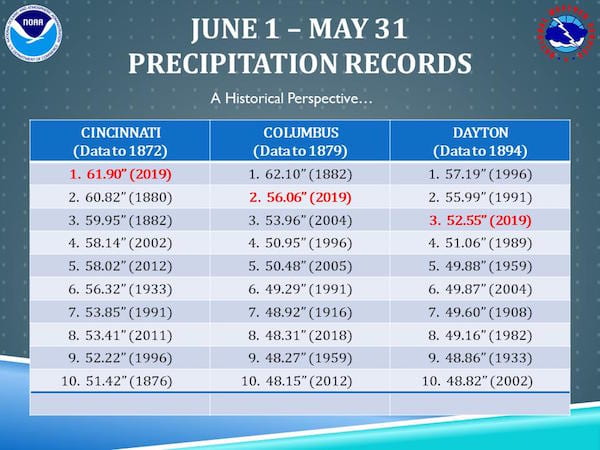Source: Farm & Dairy
May 2019 was the second-wettest month in U.S. history.
Drenching rains and historic flooding last month contributed to a record-wet, 12-month period, from June 2018 through May 2019, according to the latest climate report from the National Oceanic and Atmospheric Administration, or NOAA.
For Ohio, it was the wettest year on record in the last 124 years. (Scroll down for a chart with historical perspective of Ohio’s rainfall totals.)
Soggy conditions from June 2018 through May 2019 led to the wettest 12-month period on record in the U.S., with 37.68 inches, 7.73 inch above average. The previous June-May record was 35.47 inches and occurred from June 1982-May 1983. The previous all-time 12-month record was 36.20 inches and occurred from May 2018-April 2019.
May numbers
Exceptionally stormy conditions brought more than 500 tornado reports in May — more than double the three-year average of 226.
The average May temperature across the contiguous U.S. was 59.5 degrees F (0.70 degrees below the 20th-century average), which ranked in the bottom third of the 125-year record.
The average precipitation for May was 4.41 inches, 1.50 inches above average and ranked second wettest in the 125-year record. Nationally, the wettest month on record remains May 2015, with 4.44 inches, according to scientists at NOAA’s National Centers for Environmental Information.
Rainy year to date
Continuing a wet trend, both the spring and year-to-date precipitation totals for the contiguous U.S. were well-above average.
The spring precipitation total was 9.85 inches, 1.91 inches above average and the sixth wettest spring on record, while the year-to-date precipitation total was 15.71 inches, 3.32 inches above average and ranked as the wettest year-to-date period for the contiguous U.S. in the 125-year record.
The average U.S. temperature for the year to date (January through May) was 43.4 degrees F, which falls in the middle third of the year-to-date record.
The average temperature for the contiguous U.S. during Meteorological Spring (March through May) was 50.9 degrees F (0.10 of a degree below average), which also ranked in the middle third of the record.
Snow still fell
Duluth, Minnesota, had 10.6 inches of snow on May 9, breaking the city’s snowstorm record for May. Denver, Colorado, had its snowiest May in 44 years and tallied 3.9 inches.


